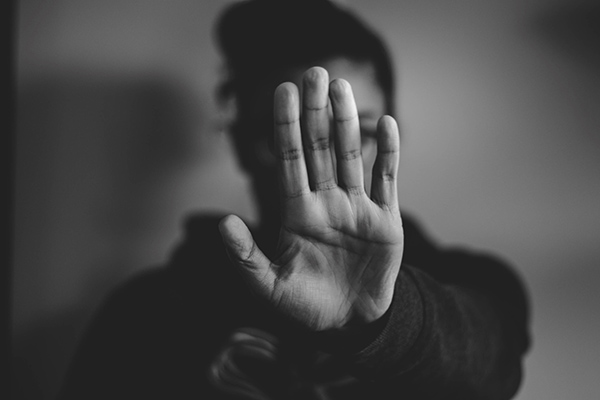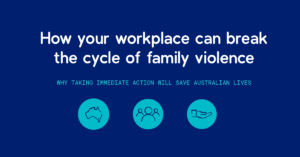Family Violence in Australia Needs Your Attention

This is a collective call to arms for workplaces to rally change
Renae Lowry, Executive General Manager, MatchWorks
Family and domestic violence has now reached a point in Australia where one woman each week and one man a month are losing their lives. Together, we can make powerful changes to stop the cycle of family violence.
With a series of three articles, we’re aiming to show you how your organisation can affect positive change. We begin here with understanding what domestic and family violence looks like today, speaking to an expert, and focusing on why your workplace is such an important driver for change.
What you need to know
The first thing you need to know is that change is possible. With such insurmountable statistics, it can be challenging to know where to begin. But your organisation, big or small, can do a lot to change the cycle of domestic violence.
Understanding family violence today
Family violence is typically centred around power and control, usually through the lens of fear. The Australian Institute of Health and Welfare links this definition to violent behaviour between current or former intimate partners (2018); however, the word ‘family’ is now broadening the idea of who could be the perpetrator and the survivor. And it’s not always expressed as physical violence.
Abuse can of course include physiological abuse, emotional abuse, and financial abuse, yet we’re still too often narrowing the definition of family violence to physical violence. We know that the stats of family violence in Australia are shockingly high, but with many people experiencing reporting barriers, they could be even higher. One barrier is this perceived idea of violence always being physical; sometimes survivors may not actually recognise that they’re going through it.
We sat down with an expert
Domestic violence expert, Abby Newman sat down with us to speak about family violence and the importance of workplace action. Newman says that the workplace is where people have the power to build cultures that become part of the solution to help break the cycle of family violence. This is also the place where we begin to raise awareness and build a collective intolerance for behaviours and attitudes that perpetrate violence. There is an effective way to reach perpetrators and people experiencing domestic violence, and it’s within your workplace.
“Our work here is centred on inspiring workplaces to take immediate action.”
How your workplace can help break the cycle of family violence
Family violence can happen to anyone, and we need to change the conversation from ‘it’s out there’, to ‘it’s everywhere’. When we have this kind of acknowledgement, we can move beyond discussion and towards action. A physical place that can improve the outcome for people impacted by family violence is the workplace.
While we know that economic independence can certainly help people who are experiencing family violence, it’s not a fix-all solution. We need to change cultural norms. We also need to educate and empower people around the issue.
Work can help people define themselves and give them self-esteem, self-confidence, and a sense of belonging. When a workplace also becomes a space that challenges harmful attitudes and behaviours including gender bias, this can help break the cycle of control and family violence.
What happens when we stay silent?
Newman says, “…there’s still a part of our community that might ask the question, ‘Well why didn’t she just leave if it’s that tough?’ We never ask the question, ‘Why does he do that?’, and that’s the change that we need to make, from blaming a person who is experiencing family violence, even when we don’t intend to blame, even when we don’t actually realise that we’re putting a responsibility for her on her.”
There are so many complexities around why people stay in violent situations and the fact is that a person experiencing family violence will be 30% more likely to end up dead if they choose to leave. That’s a frightening statistic for anyone – and as an employer, manager and/or colleague, we all need to be aware of this and have strategies in place to best support the person impacted.
Then there’s the financial impact.
“In 2015-16, the financial cost of violence against women and their children in Australia was estimated at $22 billion” (KPMG 2016). When related directly to a workplace, the financial impact comes from lost productivity, absenteeism, and high staff turnover. We know that workplaces can make a positive contribution to this issue and even a small change can make a lasting difference.
A change that affects all of us
Family violence – whether it’s expressed as physical, sexual, or emotional – is never confined to the perpetrator and the person experiencing the violence. With children involved, the cycle of violence is statistically more likely to continue. The Australian Bureau of Statistics reported that 2.1 million women and almost 900,000 men witnessed violence towards their mothers by a partner, and nearly 820,000 women and men witnessed violence towards their father, before the age of 15. It’s a cyclical issue that can be intercepted. Remember, your contribution can make a difference, because even a 5% reduction will change lives.
“A 5% reduction in family violence would prevent 6000 new cases of violence-related injury, illness and disability. It would save $38 million in health sector costs and $333 million in productivity costs over time” (KPMG 2016).
Our second article in the series will explore how three vulnerable groups experience family violence and the third article will focus on action. We deliver a breakdown of actions that you can implement in your workplace straight away; strategies that cover education, empowerment, safety, and belonging. Your commitment to change will help save lives.

References
Australian Bureau of Statistics 2017, Personal safety survey 2016. ABS cat. no. 4906.0. Canberra: ABS.
Australian Institute of Health and Welfare 2018, Family, domestic and sexual violence in Australia 2018. Australian Institute of Health and Welfare, Canberra.
KPMG Australia 2016, The Cost of Violence Against Women and Their Children in Australia. Report prepared for the Department of Social Services. Australia.